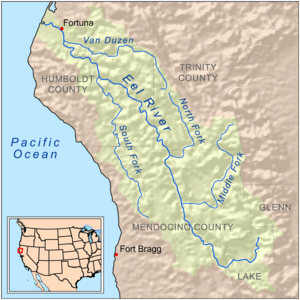Middle Fork Eel River
| Middle Fork Eel River | |
|---|---|
 Middle Fork Eel River near Round Valley, low water, 2008 | |
 Map of the Eel River drainage basin, including the Middle Fork Eel River | |
| Native name | Ba-ka-wha[1] |
| Location | |
| Country | United States |
| State | California |
| Region | Trinity County, Mendocino County |
| Physical characteristics | |
| Source | Near Wrights Ridge |
| • location | Yolla Bolly Mountains, Trinity County |
| • coordinates | 40°04′52″N 122°58′57″W / 40.08111°N 122.98250°W[1] |
| • elevation | 6,398 ft (1,950 m) |
| Mouth | Eel River |
• location | Dos Rios, Mendocino County |
• coordinates | 39°42′50″N 123°21′10″W / 39.71389°N 123.35278°W[1] |
• elevation | 863 ft (263 m)[1] |
| Length | 69.8 mi (112.3 km), Northeast-southwest |
| Basin size | 745 sq mi (1,930 km2)[2] |
| Discharge | |
| • location | Dos Rios, California[3] |
| • average | 1,472 cu ft/s (41.7 m3/s)[4] |
| • minimum | 0.39 cu ft/s (0.011 m3/s) |
| • maximum | 135,000 cu ft/s (3,800 m3/s) |
| Basin features | |
| River system | Eel River |
| Tributaries | |
| • left | Black Butte River |
| Designated | January 19, 1981 |
The Middle Fork Eel River is a major tributary of the
California Coast Range, in Trinity and Mendocino Counties. Its watershed comprises roughly 745 square miles (1,930 km2) of land, or 20% of the entire Eel River basin. The river provides groundwater recharge and is used for recreation and for industrial, agricultural and municipal water supply by residents.[5]
Course
The Middle Fork Eel River flows almost 70 stream miles.Round Valley Indian Reservation, passing within a few miles of Covelo before receiving Mill Creek from the right. Hayshed and Elk Creeks both enter from the left as the river rounds a bend to the north. Afterwards, the river's final miles are spent flowing westwards through a gorge to the confluence with the main stem near Dos Rios.[8]
Dam proposal
In 1967, the
U.S. Army Corps of Engineers proposed to build an enormous dam just above the confluence of the Eel River and the Middle Fork Eel River at Dos Rios. The Dos Rios Dam would have been 730 feet (220 m) tall, creating a reservoir that covered 110,000 acres (450 km2) of land (including Round Valley, the Middle Fork Eel River watershed's primary agricultural area and also the location of the town of Covelo, plus the Round Valley Indian Reservation).[9] If built, this dam would have diverted most of the flow of the river into the Central Valley for irrigation purposes.[10] The project was defeated by outcry from local residents and the intervention of then-California governor Ronald Reagan.[11] Reagan remarked, "Enough treaties had already been broken with the Indians".[12]
Ecology
The river provides wildlife habitat for preservation of
DFG and USFS from 1966 to 1999. In 1999 they described the Middle Fork summer steelhead run as “The largest remaining wild run of these magnificent fish”. It was noted to be “...probably the only population that has not been touched by a hatchery program, and as such, is most likely the State’s most important summer steelhead population”. Counts from the annual surveys indicated that the Middle Fork summer steelhead population has declined since 1987, to a count of 471 fish in 1999.[6]
See also
- North Fork Eel River
- South Fork Eel River
- List of rivers of California
- Yolla Bolly-Middle Eel Wilderness
References
- ^ a b c d e "Middle Fork Eel River". Geographic Names Information System. United States Geological Survey, United States Department of the Interior. 1981-01-19. Retrieved 2010-06-17.
- )
- ^ "Water-Data Report 2009 for USGS Gage #11473900 on the Middle Fork Eel River near Dos Rios" (PDF). Water Resources of the United States. U.S. Geological Survey. 2009. Retrieved 2010-06-17.
- ^ "Water-Data Report 2009 for USGS Gage #11473900 on the Middle Fork Eel River near Dos Rios" (PDF). Water Resources of the United States. U.S. Geological Survey. 2009. Retrieved 2010-06-17.
- ^ a b State of California Water Quality Control Plan North Coastal Basin 1B July 1975 p.13
- ^ a b Steelhead/rainbow trout resources of the Middle Fork Eel River (PDF) (Report). Retrieved 2010-12-07.
- ^ U.S. Geological Survey Geographic Names Information System: Beaver Creek
- ^ USGS Topo Maps for United States (Map). Cartography by United States Geological Survey. ACME Mapper. Retrieved 2010-06-17.
- ^ Wilson, Richard (1969). "The Dos Rios Project" (PDF). Round Valley Conservation League. Western Section of the Wildlife Society. Retrieved 2010-06-17.
- ^ Reisner, p. 199-200
- ^ "Undoing of the Dos Rios dam". Humboldt Herald. Retrieved 2010-06-17.
- ^ "Watershed Review" (PDF). University of Washington Water Center. Archived from the original (PDF) on 2010-06-15. Retrieved 2010-06-17.
Works cited
- Reisner, Marc. ISBN 0-14-017824-4
